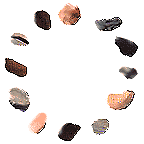
Well, better late than never. Now I have a better understanding of Transvergence and how it may be approached with a variety of work being done by a number of people these days. Here's a start on my attempt to make sense of it.
I've been trying to ignore nanotech as just another trendy academic catchword but several streams seem to be converging on what I would call granularity in economics, computing, databases, physics and aesthetics: http://en.wikipedia.org/wiki/Granularity
Oddly, it was the presentation by Ricardo and Diane at the Transvergence section of ISEA that got me thinking about granularity again after I first read about it in conjunction with the development of Apple computers and the MIT Media Lab. Even then, 1994?, I linked it to art discourse around minimalism, systems etc. especially Sol LeWitt but also a number of artists involved in art and language. Somehow this discourse got lost even though, as Sherry Turkel pointed out some time ago, the rise of computer use has revived a number of popular earlier theories through a practical usage.
Ricardo/Diane posted Keith Sanborn's essay, The Spectre of Particle Capitalism on their Transvergence website: http://www.pitmm.net/
When I start to think in terms of granularity I can then find linkages between databases, HiDef, GH, Bill Dolson and Wolfgang Staehle's current work and some of my own earlier drawings and digital work. At the same time I can understand the pseudo-scientist act Ricardo has recently adopted in terms of how Alan Moore explained the importance of the work of CAE, Zapatistas etc. to art as model that crosses categories.
As for what Transvergence actually means, here's a simplified, art-centered definition:
The term “transvergence” is an invitation to take an opportunity to rethink art history, science, and the inevitably permeable lines that arbitrarily divide these disciplines. Transvergence demonstrates an attitude that the boundaries separating academic disciplines are restrictive. It exposes the artificial construction that art and science are opposites. However, societies continue to struggle with the idea that art and science can have compatible goals. Is the linear nature of art history therefore an appropriate means of documenting and discussing transdisciplinary arts? What does transvergence mean in the context of art?
http://switch.sjsu.edu/switch/Articles/amitransvergence
You have to make a distinction between "interdisciplinary" and "transdisciplinary" but I'm not entirely sure the concept of the "two cultures" is as dominant these days as the essay author assumes (I wrote about this a long time ago for Intelligent Agent) or that artists taking on the role of scientist (Dr. Dominguez, for example) is anything more than an artful performance. Plus, it's a very simplistic reading of art history to say: "Art historians have constructed history to fit into a neat, chronological package that implies art evolves." Oh, really? You only need to read A. Richard Turner on Leonardo to know this isn't true.
In the end I'm not sure these new terms are necessary from the perspective of the artist who has been and is engaged in contemporary art discourse. These definitions may, however, be helpful for animateurs who engage the public in art work, as written about in the New York Times last week.